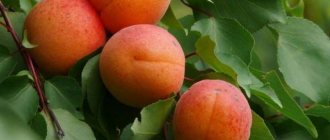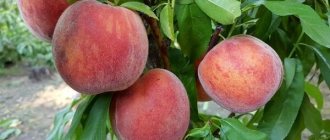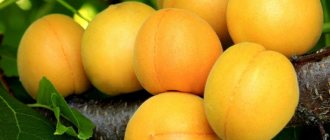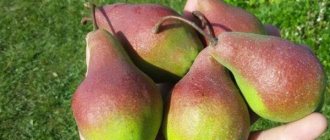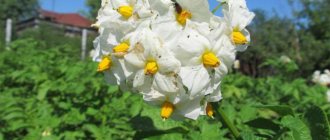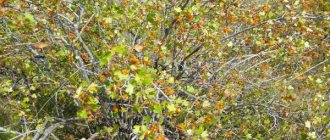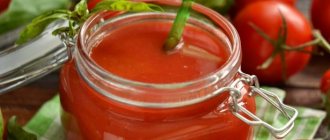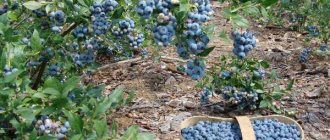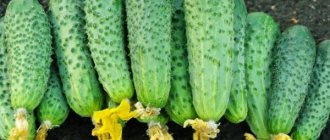History of selection
The Red-cheeked apricot variety appeared through the efforts of Crimean breeders in 1949. Its origin is unknown exactly, but it has been established that the parents of the unique fruit tree were Asian varieties, many of which are characterized by a blush on the bright yellow skin.
A distinctive feature of the Son of Red-Cheeked variety is the ruddy skin of the fruit.
From this variety they bred species no less attractive in many respects under the names: Son of Red-cheeked, Red-cheeked late, Red-cheeked Nikitsky. The hybrids Hardy, Snegirek, and Rossiyanin are considered very popular. They belong to frost-resistant species and are conventionally united under the name Red apricot.
The son of Red-cheeked inherited the main positive species characteristics from the first parent; the second is considered the apricot variety Golden Summer. The fruit crop was appreciated by gardeners and in 1974 was included in the State Register of Fruit Plants. The crop is recommended for cultivation in the Volga region and other regions of Russia, including the Moscow region.
Nuances of the Red-cheeked apricot in care and planting
As noted above, this variety is famous for its unpretentiousness, this also applies to planting and further care, but the tree will delight you with even greater productivity if you follow simple tips.
- When planting, choose a sunny, low-lying place; after all, apricot is a southern crop. Avoid salt contamination when planting; it is recommended to use rotted manure in the soil and add potassium fertilizers.
- By planting at least two seedlings close to each other, future productivity increases.
- It is better to mulch the tree trunk circle with peat or manure, allowing moisture to remain in the soil for a longer time. Carry out work carefully, to a depth of no more than 10 cm due to the nature of the root system.
- In order to prevent diseases and better reflect sunlight, the trunk is treated in spring and autumn with lime whitewash with a solution of copper sulfate.
- If signs of disease are detected, treat with special preparations.
Don't forget to share this useful information with your subscribers on social networks, and also subscribe to my blog news.
Among the huge number of varieties, red-cheeked apricot stands out for its unpretentiousness, for which it is valued by many gardeners and this variety can be found in most summer cottages. The article gives a detailed description of this variety, and also describes its hybrid - the red-cheeked apricot, which has recently begun to gain popularity.
Description of the variety
This huge fruit plant is familiar to many from early childhood. The tree trunk reaches a height of 12 m, the crown is dense, elliptical, rather spreading. Very long branches require timely pruning. The tree is characterized by a long lifespan - up to 60 years or more. The leaf blades are rounded, the pointed end is slightly turned to the side. The bark is brown and prone to cracking.
Advice! You can distinguish the variety Red-cheeked from the hybrid Son of Red-cheeked by the seed of the fruit. In the first it is bitter and unfit for food, in the second it is sweet.
Young shoots are curved and painted red. Vegetative buds are very small - up to 3 mm, and can be pressed or removed from the trunk. Generative buds do not differ in size from vegetative ones, but are more pointed in shape. They are located on annual shoots and short branches. The petiole is quite long - 20-40 mm, of medium thickness. The flowers reach 30 mm in diameter and have a pure white tint.
The fruits of the Son of Red-cheeked variety are especially attractive. They are ruddy, oval in shape, and have a longitudinal scar that extends from the base. The skin is dense and velvety. The pulp is very juicy, yellow-orange in color with a characteristic aroma. The taste is high - the fruit is sweet with a slight sourness. Weight - about 60 g. A distinctive feature of the variety is the large stone, which is easily separated from the pulp, and has a very sweet taste.
Diseases of the variety Son of Red-cheeked
Without protecting the variety from the most dangerous diseases, it is impossible to obtain a significant harvest.
Clusterosporiosis or hole spot
A fungal disease that develops intensively in early spring. The first signs of the disease are the appearance of red-brown spots on the leaves. If you do not fight the disease, then by the beginning of August all the leaves will fall off.
Control measures : spraying the crown with Horus fungicide.
Moniliosis or monilial burn
A fungal disease that transfers its spores to apricot during its flowering process. When fungal spores fall inside the flower, they infect the inflorescence and subsequently damage the shoots and leaves.
Control measures : removal of affected areas of the tree and treatment with Ridomil Gold fungicide.
Scab
It affects fruits, which begin to lag in growth and rot right on the tree. In addition to fruits, this disease can affect leaves, on which brown spots appear. If treatment is not carried out, the entire crop may be spoiled.
Control measures : collecting and removing affected fruits and leaves, as well as spraying the crown with Ridomil Gold fungicide.
Characteristics
Apricot variety Son of the Red-Cheeked has long been popular in Russia. Gardeners highly appreciated its productivity, fruiting, taste and commercial qualities of the fruit. The influence of frost on crops, as well as its advantages and disadvantages, has been well studied.
Drought resistance
Apricot Son of the Red-cheeked has a dense crown, so it will require timely pruning
The variety Son of the Red-cheeked variety tolerates drought quite easily, but the watering regime must be observed, otherwise it may negatively affect the harvest. The tree itself will not be harmed. In addition, it is important to water the crop in a timely manner in the first years after planting, until the tree has grown stronger, as well as during the formation of ovaries.
Winter hardiness of apricot Son of Red-cheeked
The winter hardiness of the crop is good, especially for trees growing in the south of the Black Earth Region. It was noted that severe frosts did not have a detrimental effect on apricots. Flower buds have a hard time surviving frosts, but this applies to sudden temperature changes. With an even decrease to critical values, the crop yield becomes average. Experienced gardeners recommend using additional methods of covering the plant if the temperature in the growing region is unstable and drops to -20 °C or lower. It was revealed that spring frosts have virtually no effect on the crop.
Do you need an apricot pollinator? Son of the Red-cheeked
The variety is self-fertile, so it does not require special planting of pollinating plants. The culture of this variety itself is capable of becoming a pollinator for many apricots that have the same flowering time.
When does the apricot begin to bloom? Son of Red-Cheeked
The flowering phase begins at the end of April or beginning of May in central Russia. This period largely depends on weather conditions. The flowering is abundant, the buds are large and white. After this period, a green mass appears on the crown of the tree.
Ripening time
According to the botanical description, the apricot variety Son of the Red-Cheeked (pictured) belongs to medium-ripening crops. The first fruits can be collected in mid-July. It is noteworthy that during the period of abundant harvest, the fruits are removed gradually, in 2-3 stages as they ripen. It should be removed in time before the apricot falls off.
Productivity, fruiting
The first harvest of the Son of Red-cheeked variety is harvested 4-5 years after planting the seedling in the ground. The average yield for a young fruit tree is about 30 kg. Then it decreases every year. It is worth noting that yields vary from year to year. This is due to the fact that flower buds tolerate the winter period differently, depending on whether or not there were significant temperature changes.
Area of application of fruits
Apricot fruits of this variety retain their structure and color after heat treatment
Son of Red-cheeked is a universal apricot variety. It is equally good in home canning - in compotes, preserves, jams, as well as pies, dried. During heat treatment, the fruits retain their color and structure, so they look quite appetizing.
Advantages and disadvantages
Like any other fruit crop, the apricot variety Son of the Red-Cheeked has pros and cons. The obvious advantages of the variety include the following:
- high productivity;
- self-fertility;
- resistance to adverse weather conditions;
- high taste qualities of fruits;
- does not require special growing conditions.
Among the disadvantages of this variety, gardeners noted the need to promptly care for the crown of the tree by pruning, as well as the sensitivity of apricot to spring frosts.
Important! Apricot Son of the Red-cheeked is highly appreciated by tasters. The taste of the fruit is given 4.7 points out of 5 possible.
Recommendations for growing crops
Apricot Son of the Red-cheeked is deservedly considered a variety that is not too capricious and demanding to care for. However, to get a harvest, the gardener will have to put in a lot of effort. Like other fruit trees, the soil around the trunk needs to be regularly weeded and loosened. It is kept clean by promptly removing fallen leaves, fallen fruits, broken branches, and other plant debris.
Watering
The son of Red-cheeked, like any apricot, is a moisture-loving crop. It especially needs moisture in May and June, when active growth of shoots occurs, flowers open and fruits set. At this time, the plant is watered every 6–8 days, using 40–50 liters of water twice a day. It is best to carry out the procedure in the early morning and evening, when the sun has set. Of course, the intervals between waterings are adjusted depending on the weather outside.
Apricot is a moisture-loving crop, but it cannot tolerate stagnation of water at the roots.
Only heated water is used for irrigation. The biggest mistake a gardener makes is watering apricots often and in large quantities . It categorically does not tolerate stagnation of moisture at the roots; they quickly begin to rot. The plant also reacts to cold water.
About a month before harvest, watering is stopped. Excess moisture at this time negatively affects the quality of the fruits; they become “watery”, less sweet, and may crack.
After fruiting, the tree can easily survive on natural precipitation. But, if autumn is dry and warm, moisture-recharging watering is required. It is carried out 4–6 weeks after harvest, spending 70–90 liters of water per adult tree.
The apricot root system is superficial, so pouring water under the roots is not recommended. If they are exposed, they will dry out very quickly. For irrigation, 2–3 grooves are dug, located around the trunk in the form of concentric circles. If technically possible, apricots are watered using the sprinkling method. This allows you to evenly wet the soil.
Each time after watering, the soil in the tree trunk circle is loosened. The mulch layer is renewed as necessary.
After watering, it is advisable to renew the layer of mulch - it will retain moisture in the soil and help save time on weeding
Fertilizer application
Fertilizers contained in a properly prepared planting pit will provide the apricot seedling with nutrients for the next season. Fertilizing begins only from the second year of the tree’s stay in open ground.
In the spring, the Son of Red-Cheek needs nitrogen. Fertilizing is carried out before the leaves bloom. This macronutrient helps the tree “wake up” and grow green mass at an accelerated pace. 30–40 g of urea, ammonium sulfate, ammonium nitrate in dry form or as a solution (2 tablespoons per 10 liters of water) are distributed in the tree trunk circle. First you need to loosen the soil. It is strongly not recommended to exceed the norm and dosage of nitrogen-containing fertilizer. And during the period of fruit ripening, this macroelement is even harmful. Its excess weakens the plant’s immunity; all energy goes into feeding the green mass. There are no more nutrients left for the apricots themselves.
Urea, like other nitrogen-containing fertilizers, is beneficial for the plant, but only if they are applied on time and in the right doses
You can divide the recommended dose into 2-3 servings. In this case, nitrogen is applied immediately before flowering, immediately after it and 7–10 days after the second feeding. Another option is to use mineral fertilizer only for the first feeding, and organic fertilizer for the other two. Most often, this infusion is prepared from dandelion leaves or nettle greens, but, in principle, any weeds growing in the garden will do. The greens are finely chopped, filled with water, the container is tightly closed and left for 3-4 days in a warm place. Before use, the infusion is filtered and diluted with water in a ratio of 1:8. Fertilizer is prepared in the same way from fresh cow manure or bird droppings, but the latter will require twice as much water.
Nettle infusion is a natural source of nitrogen and other macroelements necessary for apricot
Red-cheeked's son prefers nutritious soils. Like any apricot, it reacts negatively to a deficiency of micro- and macroelements in the soil. To increase the fertility of the substrate, humus or rotted compost is added to the tree trunk circle once every 2–3 years (20–30 liters for a tree under five years of age and 50–60 liters for adult apricots).
Humus introduced into the tree trunk helps increase soil fertility
Ripening fruits need potassium and phosphorus. To do this, during the formation of fruit ovaries, apricots are watered with a solution of potassium sulfate and superphosphate (25–30 g and 50–60 g per 10 l, respectively). A natural alternative is an infusion of wood ash (a liter jar containing 3 liters of boiling water).
The last fertilizing is carried out approximately a month after harvesting. Nitrogen is excluded from its composition. The simplest option is complex phosphorus-potassium preparations (ABA, Autumn). You can also use a solution of superphosphate and potassium sulfate, or an infusion of ash. If the soil is acidic, dolomite flour is added every 2–3 years (200–300 g per 3 m2 of tree trunk circle).
AVA is a popular complex fertilizer designed specifically for autumn feeding of garden crops.
Son of the Red-cheeked also reacts positively to foliar feeding. During the growing season, a tree whose condition you are not satisfied with can be sprayed 2-3 times with a solution of any complex mineral fertilizer (Good Power, Master, Novofert, Zdraven). Or you can prepare it yourself by dissolving 1–2 g of potassium permanganate, zinc sulfate, copper sulfate and boric acid in a liter of water.
Complex mineral fertilizers are used if the tree is lagging behind in development; foliar feeding also has a positive effect on apricot immunity
Red-cheeked's son is especially sensitive to potassium deficiency in the soil. If there is a shortage of it, the tree ages very quickly, dries out and almost inevitably dies. A natural source of potassium is wood ash. Several times during the season it can be scattered in a circle around the tree trunk.
Trimming
The apricot variety Son of the Red-Cheeked is distinguished by its growth rate, so you should not forget about pruning. It helps to increase the yield and quality of fruits. In addition, a tree with a neat crown is much easier to care for and is much less likely to suffer from diseases and pest attacks. The best time for it is early spring. You need to be there before the leaves bloom, but the temperature must be positive.
The first time the procedure is carried out when planting the tree, shortening the central and lateral shoots. The crown begins to form for the next season. The most common configuration for apricot is sparsely tiered. It takes 4–5 years to form. The finished crown consists of 3–4 tiers of 5–6 skeletal branches in each. On each of these shoots there are approximately the same number of branches of the second and third order. The rest are cut to the growth point. The height of the tree is adjusted by shortening the central conductor 30–40 cm above the last tier.
The formation of a sparsely tiered apricot crown takes 4–5 years
When choosing, they are guided by how well the branch is located and at what angle it departs from the trunk. They immediately get rid of shoots that grow down and deep into the crown, thicken it, are thin, and deformed. It should be evenly illuminated and warmed by the sun.
Don't forget about sanitary pruning. In the spring, branches that are frozen or broken under the weight of snow are removed; during the summer and autumn, branches that are dried out, damaged by diseases and insects are removed.
For pruning, use only sharpened and disinfected tools. The cuts are made as even as possible, trying not to “fragment” the wood and not leave “stumps”. “Wounds” are also disinfected by washing with a 2% solution of copper sulfate and covering with garden pitch. If you don’t have it at hand, apply several layers of oil paint.
Any tool used for pruning must first be kept in a 5% solution of copper sulfate or saturated raspberry - potassium permanganate
If the tree regularly freezes in winter, it is recommended to shorten all one- and two-year-old shoots by 12–15 cm at the end of August. The plant will begin to prepare for the cold in advance, and the branches will thicken. A good replacement for skeletal shoots damaged by frost can be “tops” (powerful branches growing almost vertically, on which there is no harvest). Usually they are cut off immediately, but 2-3 pieces can be left if you plan to rejuvenate pruning or crown formation.
We must not forget about crop rationing. Like most fruit trees, the apricot bears many more fruits than it can “feed”. But the apricot is not able to shed the excess on its own. Therefore, approximately half of the ovaries that have reached 2–3 cm in diameter need to be torn off, leaving those that are better located. After this procedure, the fruits are larger, juicier and sweeter.
Experienced gardeners recommend immediately picking off the flowers that form on apricot seedlings in the first and second seasons of being in open ground. This is necessary to allow the tree to “concentrate” on growing green mass and forming a root system.
The son of Red-cheeked is prone to the formation of basal shoots. It takes a lot of strength from the tree, without producing a harvest. Therefore, it needs to be cut off without leaving “stumps”. To do this, they dig up the ground at the roots and use sharp scissors to cut the one that leads to a new shoot. As an exception, you can leave 3-4 cuttings for propagation.
Video: tips for pruning apricot
Preparing for winter
Preparing for winter for any apricot is a mandatory procedure. Even the most cold-resistant varieties bred by breeders are not distinguished by high frost resistance. The “Achilles heel” of the Son of Red-Cheek variety is the flower buds. Wood suffers from frost relatively rarely.
Apricot is a southern crop, so it must be protected from winter cold
The first thing to do is to clear the trunk circle of plant debris, loosen the soil and renew the layer of mulch, bringing its thickness to 8–10 cm. Then the trunk to the first fork and the lower third of the skeletal branches are covered with a special composition based on slaked lime. You can buy it in a store or prepare it yourself by mixing it with water, powdered clay, office glue and copper sulfate. A mound of peat or humus about 20–25 cm high is poured around the trunk.
Slaked lime helps protect wood from rodents
Slaked lime quite effectively repels rodents, which in winter are not averse to feasting on the fragrant wood of the fruit tree. But to guarantee, you can wrap the trunk with several layers of burlap, any other breathable covering material, or even nylon tights, laying them with pine tree branches.
A layer of mulch near the trunk will prevent the roots from freezing
Young seedlings especially need protection for the winter. If dimensions allow, the trees are covered with cardboard boxes, stuffed with scraps of newsprint, sawdust, and shavings. It is undesirable to use straw - mice often breed in it. When the tree has already grown, a “hut” is built around it, stretching burlap over a frame of twigs or poles.
Video: growing apricots in central Russia
Landing Features
Every gardener, planning to plant an apricot on his plot, must take into account that this crop is southern. Therefore, her preferences should be taken into account, despite the fact that breeders have instilled unpretentiousness in the Son of Red-Cheeked variety. The first thing you need to take care of is choosing a place for the apricot and the recommended planting time.
Recommended timing
In most of Russia, apricots are planted in the spring. By observing this condition, the crop manages to form a strong root system by autumn and undergoes complete adaptation. Further, apricot easily tolerates winter and frost.
Choosing a suitable location
For full growth and development, and fruit ripening, apricots will need a lot of sunlight. Gardeners need to make sure that the place is at some elevation, located in the south and west of the site. Lowlands should be excluded, otherwise excess moisture will destroy the root system, and then the entire apricot. It’s good if there is a house wall or fence next to the tree. This will protect the culture from unwanted drafts. If these conditions are not met, fruit quality and yield gradually decrease.
What crops can and cannot be planted next to apricots?
Apricot does not tolerate close proximity to other crops
Since the crown of the Son of Red-cheeked apricot variety is quite spreading, when planting other fruit trees nearby, you need to maintain an interval of 5 m. Of the flowers near the apricot, bulbous ones will do well - daffodils, tulips, crocuses, hyacinths. They bloom at a time when the tree is not yet covered with green mass.
It is a very bad idea to place vegetables under an apricot. Nothing good can come from such a neighborhood. It is not recommended to plant shrubs, since the apricot crown will not allow enough light to pass through, which is necessary for currants, raspberries, and gooseberries. Therefore, the only option for a harmonious neighborhood is lawn grass.
Selection and preparation of planting material
It has been noticed that two-year-old apricot seedlings take root most successfully in the soil. As a rule, they are no more than 70 cm high. The bark should be smooth and elastic. It is necessary to have 2-3 kidneys. The root system of the plant should not have visible damage or signs of mold. It is important to check the vaccination site. Otherwise, there is a high probability that the seedling was grown from a seed. Such specimens rarely inherit the varietal characteristics of their parents.
Landing algorithm
The landing algorithm is simple and looks like this:
- After purchasing a seedling, you should soak its roots for a day in a biostimulator solution, then cut off the dry and black areas.
- At the bottom of the hole, make a small mound of soil and drive a wooden peg to support the seedling from the winds.
- The seedling is placed in a hole, carefully distributing the roots. When filling it with soil, you need to make sure that the root collar remains on the surface by 5-7 cm.
- Compact the soil well and water the seedling generously with water at room temperature.
- Tie the plant to a support.
It is important to protect the apricot seedling from direct sunlight for several weeks.
How to plant?
This apricot belongs to the light-loving fruit crops. This factor must be taken into account when choosing a place to plant a tree. The distance between the soil surface and groundwater must be at least two and a half meters. The soil should not be dense. Red-cheeked apricot will feel quite comfortable in light loamy, loamy or low-carbonate soils, the acidity level of which is from 7 to 8 pH.
It is important to note that this variety cannot be planted in soil that contains lime.
The place to plant the tree should be on a hill. It is also desirable that the selected area be protected from gusts of wind, for example, located behind a high fence or forest belt. It is not recommended to plant fruit crops in a shaded area, which is located in a lowland, where there is a possibility of stagnation of moisture in the soil. As protection from wind and drafts, you can build a wooden shield made of boards on the east or north side, which prevents the wind from affecting the tree. When the tree reaches 4 years of age, such a fence can be removed.
Features of the planting process are as follows:
- It is recommended to plant apricots in the spring, preferably at the end of April, or in the fall, in mid-October.
- Planting is not recommended during the growing season.
- Regardless of the planting time, the pit must be prepared in advance. This action will allow the soil to shrink, making it much easier to place the plants in the hole.
- If you are preparing plants for planting in the fall, then the recess should be prepared a couple of weeks before the procedure. If planting will be carried out in the spring, holes are dug in the fall, in October or November.
- The distance between the apricot and other trees in the garden should be about 5 m. The same distance must be maintained if you are planting several seedlings at once.
Step-by-step description of landing
Landing consists of the following manipulations:
- First of all, you need to dig a hole about 80 cm deep and about 70 cm wide.
- A drainage layer of about 10 cm must be laid at the bottom of the hole. Branches, gravel or twigs can be used as drainage.
- After this, 15 kg of humus, 2 kg of ash, 500 g of superphosphate, 1 kg of lime, 100 g of potassium salt and 200 g of ammonium nitrate are poured into the pit. All elements must be mixed with the ground in equal parts. It is also important to note that the root system of the tree should not come into contact with fertilizing without soil, otherwise the apricot will get burned.
- After this, the hole must be filled with the mixture and formed into an elevation.
- Apricots are planted on a mound. The seedling is installed in a vertical position, while the root system is distributed and sprinkled with soil. It is recommended that two people perform this procedure.
- The root collar of the seedling is not covered with soil; it should be located 3 cm above the ground.
- After this, the soil is well compacted. After planting, the seedling must be watered with two or three buckets of water, after which the soil near the trunk is mulched with a layer of peat or manure about 10 cm thick.
It is important to note that red-cheeked is a self-fertile variety, so pollinators are not required for planting.
You can also grow a tree from a seed. To do this, the bones are soaked in warm water for a day. After this, the seeds are placed in holes about 6 cm deep every 15 cm. When the plant is 2 years old, it must be transplanted to a permanent place.
Subsequent care of the crop
The apricot variety Son of the Red-Cheeked is one of the unpretentious crops. However, it requires basic care. Like all plants, apricot needs timely watering, pruning the crown, fertilizing, and loosening the soil in the tree trunk circle. Preparation for the winter period is no less important, despite the crop’s resistance to frost.
Attention! Experts have proven that apricot fruits, due to their vitamin composition, have a positive effect on metabolism and the functioning of the digestive tract.
Reviews of the variety Son of the Red-cheeked
Sergey, Okhansk, Perm region
The variety is characterized by high yields and ease of cultivation. Winter hardiness is high, but I still cover it for the winter. I will say one thing about apricot, the taste is great.
Natalya, Orenburg
They have been raising Red-Cheeked Son for a long time. No complaints. The trees tolerate both drought and severe winter frosts well. Apricots are large and tasty. I collect 20-25 kg from one tree. delicious fruits.
Alexander, Penza
I chose Red-cheeked on the advice of a neighbor in the garden and did not go wrong. A productive and frost-resistant variety, except for a few frozen branches. The trees are growing quickly; I received my first harvest in the fourth year. The fruits are large and tasty. Some years I collect 30 kg from one tree. fruits
Advantages and disadvantages
The red-cheeked one pleases with its precociousness, but does not tolerate frosts
The advantages of this variety of apricot include the following aspects:
- resistance to drought and low temperatures;
- self-fertility;
- ability to resist diseases;
- precociousness;
- high productivity;
- undemanding to soil;
- high taste qualities.
The disadvantage of the culture is its sensitivity to sudden temperature changes. The most dangerous period for red-cheeked apricot is spring, when thaw alternates with frost. Such fluctuations negatively affect flower buds, which can even die from unstable temperatures.
Diseases and pests
Characteristic diseases and treatment methods - table
| Diseases | Symptoms | Ways to fight |
| Gray rot (monoliosis) |
| Spraying with Decis (1 g per 10 l of water, consumption 3–4 l), Fufanon (10 ml per 10 l of water, consumption 3–5 l per tree). |
| Hole spot (clasterosporiasis) |
| Treatment with 1% Bordeaux mixture (100 g of lime, 100 g of copper sulfate per 10 liters of water, consumption for a plant up to three years old - 2 liters of solution, for a fruit-bearing tree - 10 liters). |
| Brown spot (nomoniosis) |
| Treatment with Bordeaux mixture (100 g per 10 liters of water, consumption - 2-3 liters). Spraying is carried out when buds open, after flowering, 3 weeks before harvest. |
The main types of apricot diseases in the photo
Typical pests and measures to combat them - table
| Pests | Signs | Fighting methods |
| Yellow sawfly | Butterfly 5 mm long. The caterpillars reach a size of 9 mm. Presence of oviposition in buds and buds. | Treatment 30 days before harvest with Karbofos (60 g per 10 liters of water, consumption - 2-10 liters per tree). |
| Eastern moth | A butterfly with gray wings, the span of which reaches 15 mm. The caterpillars are red with a brown head. Their length is 1.3 cm. The appearance of oviposition on shoots and the outside of leaves. | Spraying with Karbofos according to the instructions. |
| Plum aphid | Deformation of the upper part of shoots and leaves. | Spraying with 0.2% Fazalol solution. |
| Rodents (rats, mice, hares) | Violation of the integrity of the cortex. |
|
Secrets of effective care
Hydration
A newly planted apricot requires watering 5-6 times per season in the amount of 2-3 buckets of water. As the tree grows, it is advisable to reduce the frequency of watering, while increasing their volume. Red-cheeked apricot needs abundant watering in May - June, during the period of active crown growth. In the future, the soil should be moistened only in case of severe drought. Otherwise, the apricot will produce late young shoots, which may freeze without having time to get stronger before winter.
Top dressing
- To stimulate growth, every spring it is necessary to fertilize the apricot tree with nitrogen compounds (20–30 g per 1 sq. m of trunk circle). Exceeding these standards will lead to the death of the tree.
- Organic fertilizers (peat or horse manure), which help increase productivity, are recommended to be applied once every 3 years.
- It is advisable to periodically add calcium to acidic soils.
- The productivity of fruit-bearing trees is increased by annual feeding with a mixture of ammonium nitrate, potassium salt and superphosphate in a ratio of 4:3:1. The amount of such fertilizer should not exceed 50 g per 1 square meter. m.
Trimming
This is a necessary condition for apricot productivity. Immediately after planting, you need to trim the trunk and skeletal branches. The optimal crown pattern is sparsely tiered (bowl-shaped). Its basis is made up of 5–6 skeletal branches located at a large angle to the trunk. The growth of branches from one point of the trunk is unacceptable. This causes thickening of the crown. Such trees lack light and bear fruit poorly.
The formation of an apricot crown in the first years after planting is the key to stable fruiting
The fruits are formed on annual shoots. In spring they need to be shortened by half. This will allow the development of flower buds on the remaining part.
After harvesting (at the end of summer), it is necessary to carry out anti-aging pruning. Mature trees should not be shortened too much.
Whitewash
Treating the trunk with a solution of copper sulfate and lime in early spring and late autumn will protect the tree from cracking as a result of temperature changes. If, when examining the plant at the end of April - at the beginning of May, wounds were still found, they must be covered with garden varnish, preventing the sap from flowing out and weakening the tree.
Pest and disease control
The most common pest of apricots is aphids. To combat it, chemical agents intended for this purpose are suitable. You can repel aphids by planting nasturtiums around your apricot.
Some diseases also prevent apricots from developing:
- moniliosis;
- brown spot;
- Clusterosporiosis;
- Verticellium wilt;
- infectious drying out;
- leaf curl.
Under their influence, brown spots appear on the fruits, a sticky brown substance appears on the crown, and ulcers appear on the buds and branches. Leaves curl, lose color and fall off. At the first such symptoms, the plant should be treated with special preparations that act on a specific disease. For example, treatment with Bordeaux mixture and copper-containing preparations gives a good effect in such cases.
Important! The affected areas are not restored. To prevent the spread of disease, they should be removed and burned.
